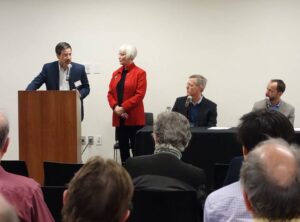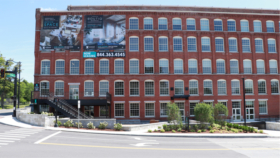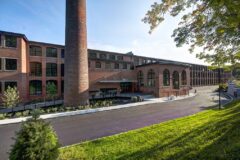(L-R – Greg Galer, executive director of the Boston Preservation Alliance, Jean Carroon, principal at Goody Clancy and leader of the firm’s preservation practice; Matthew Bronski, principal and historic building specialist at Simpson Gumpertz & Heger; and Brian Swett, director of Cities and Sustainable Real Estate at ARUP at Urban Forum on Climate Change)
by Mike Hoban
Boston – On the heels of a winter that saw a pair of powerful nor’easters generate unprecedented levels of flooding along Atlantic Avenue and in the historic Fort Point Channel Landmark District, the Boston Preservation Alliance and the Association of Preservation Technology Northeast (APTNE) parlayed a heightened sense of urgency into an opportunity to begin a dialogue on how to best address the effects of climate change on the City of Boston’s historic treasures. Hosted by the Boston Society of Architects/AIA (BSA) at the Fort Point Room in the Atlantic Wharf Building on April 18th, the forum provided an overview of the issues at hand while also addressing some of the roadblocks to developing a workable preservation strategy.
The event featured presentations by Brian Swett, director of Cities and Sustainable Real Estate at ARUP, and Matthew Bronski, principal and historic building specialist at Simpson Gumpertz & Heger, followed by a discussion moderated by Jean Carroon, principal at Goody Clancy and leader of the firm’s preservation practice.
According to the National Centers for Environmental Information (NCEI), the U.S. has sustained 230 weather and climate disasters since 1980 where the costs of damage reached or exceeded $1 billion. Since 2011, there has been an average of over a dozen such events annually, with 2017 registering the worst year in history – 16 events and over $300 billion in damages. Last year shattered the previous U.S. annual record cost of $219 billion that occurred in 2005 due to the impacts of Hurricanes Dennis, Katrina, Rita and Wilma.
But catastrophic events are not the only threats to the built environment, cautioned Swett. “Oftentimes we focus on the acute disruptors – the major storms such as the ones we had this winter – heat waves, earthquakes, and flooding events – while we don’t give enough (attention) to the chronic stressors – those that are both man-made and natural.”
He cited a study by the Union of Concerned Scientists that states that while global sea levels have risen approximately eight inches since 1880, it has occurred at much higher rates along parts of the East Coast, including Boston (nearly 10 inches since 1921). By 2030, more than half of the 52 communities in the study are projected to experience, on average, at least 24 tidal floods per year in exposed areas, assuming only moderate sea level rise projections. And twenty of those communities could see a tripling or more in tidal flooding events. “They will become chronically inundated communities at high tide, and that’s not an acute event, that’s a predictable chronic stressor,” Swett noted.
Swett says there are a “full myriad” of climate change impacts expected to affect Massachusetts, including extreme temperatures. By mid-century, the Boston climate will resemble Maryland’s, and by 2100, the Carolinas. So instead of an average of five 90-plus degree days annually, there would be 45-90 days of extreme heat, which would have a significant impact on buildings – none of which were designed to handle the stress of prolonged heat waves. Boston also experienced extreme temperature swings this past winter (which is consistent with climate change) that produced an accelerated freeze/thaw cycle, “and those types of extremes, from a building perspective – particularly historic buildings – were not designed for that type of challenge.”
Bronski focused his presentation on the effects of chronic stressors in microclimates within a given city, and how traditional construction strategies were used to mitigate those effects in older buildings. Citing examples from more mature cities such as Rome and Venice as well as Boston, he demonstrated how design concepts such as shedding and sheltering (constructing buildings in a form akin to an inverted pyramid) prevent or decelerate the weathering process. Bronski identified water and salts “as the two most foremost agents of deterioration of historic building materials” with the crystallization of waterborne salts often wicked into buildings causing the most damage to structures, and noted that the use of de-icing salts is also taking its toll on historic buildings.
In order to prevent deterioration (particularly with buildings using softer materials such as brownstone and sandstone), builders in Boston have traditionally used Quincy granite at the base of buildings, which fares much better in standing up to water and salt. With rising sea levels and increased frequency of flooding, however, these historic methods will be less effective. Existing granite structures may need to be fortified, and buildings without such protections should be modified.
While there are a number of legislative and administrative solutions (of varying levels of merit) in the works by the City of Boston to address resiliency, there remain questions to be answered by the preservation community as to how to best develop a workable strategy to preserve historic buildings. During the panel discussion, Carroon cited a presentation by MIT professor Dr. Sarah Slaughter, founder of Built Environment Coalition (who was scheduled but unable to attend), who maintains that, in order to preserve many of the historic structures in Boston, there needs to be some degree of compromise by the preservation community on priorities and standards.
“One of my standing questions (with regard to ways of making historic buildings more resilient, energy efficient, and adaptable for re-use) has been, ‘Are we too rigid in our preservation guidelines and our interpretation of what can and should happen to the designated buildings?” she asked. Carroon also addressed a second issue, that of the economic realities of historic preservation. “The economic pressures on existing buildings are the greatest challenge,” she stated, and with new building codes coming into place that require existing buildings to meet seismic and accessibility requirements, “we constantly come up against the fact that it is less expensive to replace a building than to change it.”
Carroon’s comments led to a lively panel discussion, with Bronski reminding the gathering to think about the preservation of the historic buildings for the long term, which means “being more permissive about what we can do to make them more resilient moving forward so that they will be here a couple of generations from now.” There was also a reminder of the many positive environmental aspects of historic buildings, which tend to rate better on energy use surveys in cities like New York and Boston than many newer structures. Historic buildings were usually built with natural heating and cooling in mind, using durable, high thermal mass materials.
Following the program, Greg Galer, executive director of the Boston Preservation Alliance, said there has been some discussion within the preservation community about talking with the National Park Service about preservation standards – which are written to be fairly flexible but tend to be interpreted fairly tightly. “I think it’s an active conversation and it’s going to take a little bit of bravery to embrace the fact that we have to be somewhat more flexible,” said Galer. “We’re about thoughtful change, not about stopping change, and I think we need to look at all of these items as opportunities to enhance the conversation, with the understanding of how historic buildings fit within the needs of the city.”



